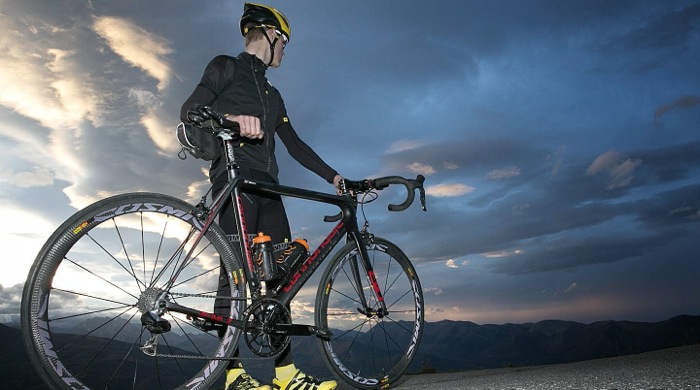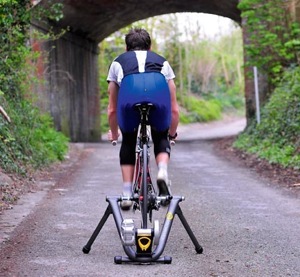
Interval training can be tailored to suit different requirements in your riding. For example: you can create your own intervals based on the need to increase strength, acceleration, speed, endurance or even constant changes in pace. It all comes down to one key concept - to help your body acclimatise to the specific stress that a certain activity will place upon your system.
As your body becomes more acclimatized, you could say that it adapts to these stresses and becomes better at handling the various issues associated with increased physical exertion. (lactic acid, increased heart rate, insufficient oxygen intake etc).
Related article: "A beginner's guide to interval training"
NOTE: Your body will very quickly lose its adaptation to the stress you place upon it. If you stop doing the training, your body soon realises it is no longer needed to perform at an unusually high level. It soon drops back to your previous 'normal' self.
THREE ENERGY SYSTEMS
Your body has three energy sources by which it powers it's daily locomotion. However when you're riding you tend to use these three energy systems in a very interchangeable way; meaning that you can frequently switch from one energy system to the other - something you wouldn't really do in daily life off the bike. Here are the three energy systems:
1. Oxidative System
This energy system supports long distance consistent efforts such as a hike, walking to work, or an easy ride at a low heart rate. Your body can go all day on this energy system provided you supply it with fuel by means of food.
2. Glycolytic System
This energy system generally provides the steam behind strength associated efforts, but of a lower intensity. Think of carrying heavy boxes upstairs.
3. ATP-PC System
Adenosine Triphosphate / Phosphocreatine, the rocket fuel of your energy systems. This energy source provides the fuel for very brief, high intensity efforts. Off the bike, you could think of exercises such as vertical jumps. On the bike, you could think of the final kick in your sprint.

Nearly all of your daily activities are fuelled by ATP (adenosine triphosphate). Your oxidative and glycolytic energy systems make this ATP fuel to order, creating energy parcels from the food you eat and the air you breathe. But while your body is facilitating this ATP production, it also stores small packages of ATP away in your muscles for when you need to expel extreme amounts of power and strength.
When your muscles use this store of ATP, it recycles the by-products. Your body adds Phosphate Creatine to the waste product, turning the waste back into fuel to burn. This is where the title comes from, ATP-PC. It's like energy production on a loop, going around and around. BUT... if you produce too much waste material in the form of lactic acid, your body can't convert it to fuel quickly enough. The recycling process falls behind schedule, and you are left with excess lactic acid which we're all too familiar with: (burning muscles).
JOIN THE DOTS
So now you know your three energy systems, let's give them an activity you can relate to - cycling!
1. ATP - PC SYSTEM
- PRIMARY FUEL: Adenosine Triphosphate and phosphocreatine, stored within your muscles.
- SPEED: Very fast, and explosive.
- RANGE: Very short, between 5 - 10 seconds of burn time. It takes around 2-4 minutes to refuel.
- EXAMPLE: Sprinting 110% effort, or swinging a bat as hard as you can.
- HOW TO IMPROVE: Do frequent hard efforts of 10 seconds approx, with lengthy breaks of 3-5 minutes.
- RESULT: An ability to deliver more power and speed. Sadly your body can't learn to store more fuel!
2. GLYCOLYTIC SYSTEM
- PRIMARY FUEL: Carbohydrates
- SPEED: Medium to fast efforts, usually as your ATP-PC system runs out of fuel, this steps in.
- RANGE: Around 1-4 minutes of burn time, depending on your abilities and fuel availability.
- EXAMPLE: Closing down a breakaway, or attacking on your favourite climb.
- HOW TO IMPROVE: Do 1 - 3 minute efforts at 85-90% RPE, with 2-3 minutes of rest between efforts.
- RESULT: Improved ability to extend power output, and increase power output. Quicker recovery as well.
3. OXIDATIVE SYSTEM
- PRIMARY FUEL: Fat
- SPEED: Slow - you're using it right now! It also fuels your recovery from the other two systems.
- RANGE: Endless? If there's fuel, this system works.
- EXAMPLE: A slow walk, a very easy ride or even a light jog.
- HOW TO IMPROVE: Do 8-20 minute efforts @ 75-80% RPE, with 10 minute rests in between.
- RESULT: Improved base level outputs and increased efficiency. The increased ability to ride further, and hurt less.
That should give you a basic overview of what intervals are actually doing. Different intervals are designed to target one of the three energy systems mentioned above. Not only that, but the muscles associated with the exercise also become more efficient and potentially larger.
DIY - DO INTERVALS YOURSELF

Take a look at your own abilities, and choose a weakness. Go on, be harsh on yourself. Are you perhaps a bit slower on the climbs, or do you struggle to ride more than 1 hour at a time? Maybe you're quite fit, but never beaten your mates in a sprint...
Now choose which energy system your weakness depends on. We've decided that we can't keep up with the bunch when the pace exceeds 45 km/h on the weekend, usually near the end of the ride. Lay yours out like this;
WEAKNESS
Keeping up when riding at high intensity - 40 km/h near end of bunch ride.
ENERGY SYSTEM
Glycolytic System
SOLUTION
Short 1-4 minute efforts with 3 minute rests in between.
RESULT
Ability to increase output for short periods of time, so I can keep up!
As a quick training plan, you can decide to do this 2-3 times a week depending on your riding schedule. We've taken the above information, and will do the following on three rides this week;
- 2 x 4 min efforts @ 75% RPE
- 3 MIN REST
- 3 x 3 min efforts @ 80% RPE
- 3 MIN REST
- 3 x 2 min efforts @ 85% RPE
- 3 MIN REST
Have a go at it yourself, and see what you come up with. Be prepared to change your intervals as you go because you'll usually underestimate the difficulty of the efforts.
This is far from a scientific paper but it does give you a good understanding how how energy systems work and how you can improve their abilities. You can now also go about creating small interval programs for yourself just to see what the results are! We strongly recommend consulting a professional before you undertake any training thus ensuring your program is best suited to your circumstances and abilities.
But for now, get out there and give it a go - at least you'll have some idea of what you're doing next time you head out for a training ride. Have fun, ride safe and don't forget to watch the road instead of your cycling computer!


